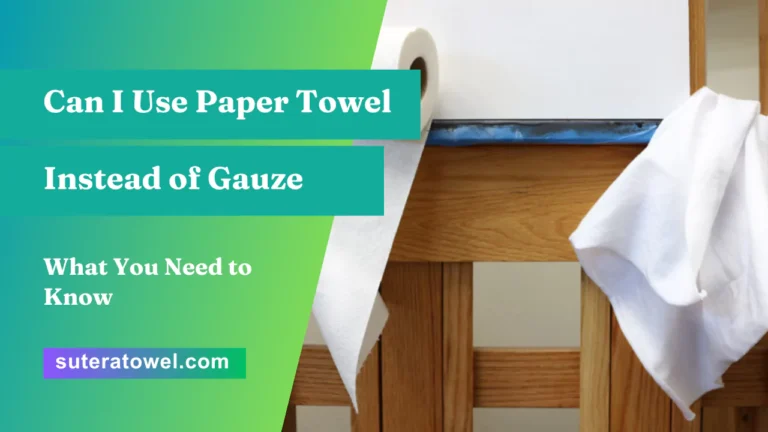Yes, paper towels can be used as a substitute for gauze. Paper towels can serve as an alternative to gauze due to their absorbent nature and ability to provide temporary wound protection.
It can be used to stop bleeding, cover wounds, and absorb fluids. However, it is important to note that while paper towel can be a temporary solution, it is not designed specifically for medical purposes like gauze. Gauze is sterilized, lint-free, and less likely to adhere to the wound, making it a more ideal choice for wound care.
It is always recommended to consult a medical professional for proper wound care and to determine the most suitable materials for your specific needs.
The Difference Between Paper Towels And Gauze
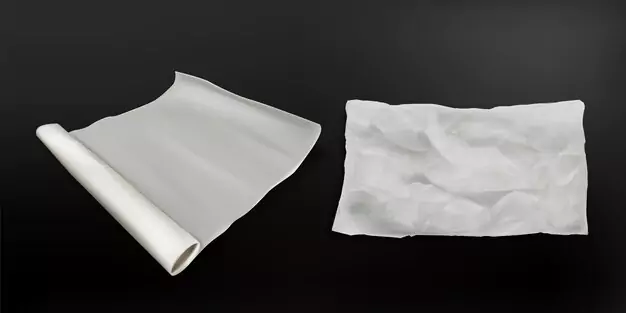
Paper towels and gauze serve different purposes, with gauze being more suitable for medical applications due to its sterile nature. While paper towels may provide temporary support, it’s best to use gauze for wound care to prevent infection and promote healing.
Paper towels and gauze are commonly used for various purposes, including wound care. While they may seem similar, there are important differences between the two in terms of absorbency levels, texture and durability, and their impact on wound healing. In this section, we will explore these differences in detail.
Absorbency Levels Of Paper Towels Vs. Gauze:
- Paper towels are designed to be highly absorbent and are primarily used for cleaning spills and drying surfaces.
- Gauze, on the other hand, is specifically created for wound care and is designed to effectively absorb blood and other bodily fluids.
- Gauze has a greater absorbency capacity than paper towels, making it more suitable for wound management.
The Texture And Durability Comparison:
- Paper towels are typically made of wood pulp fibers, which provide a soft and smooth texture. However, they may disintegrate or leave a residue when in contact with liquids or moisture for an extended period.
- Gauze, on the other hand, is made from a variety of materials such as cotton or synthetic fibers, providing a slightly coarser texture. It is designed to maintain its integrity even when wet, ensuring that it stays intact during wound dressing changes.
How Paper Towels And Gauze Affect Wound Healing:
- Paper towels, due to their high absorbency levels, can quickly draw moisture away from the wound. However, they may stick to the wound bed, causing pain and disrupting the healing process.
- Gauze, with its superior absorption and non-stick properties, promotes a moist wound environment, which is crucial for optimal healing. It allows the wound to breathe and helps prevent the formation of scabs, facilitating faster healing.
While paper towels and gauze serve different purposes, the choice between them for wound care ultimately depends on their respective properties. Gauze is specifically designed for wound management, offering superior absorbency, non-stick qualities, and durability. Therefore, when it comes to wound healing, gauze is the more appropriate choice over paper towels.
Risks And Limitations Of Using Paper Towel As A Substitute
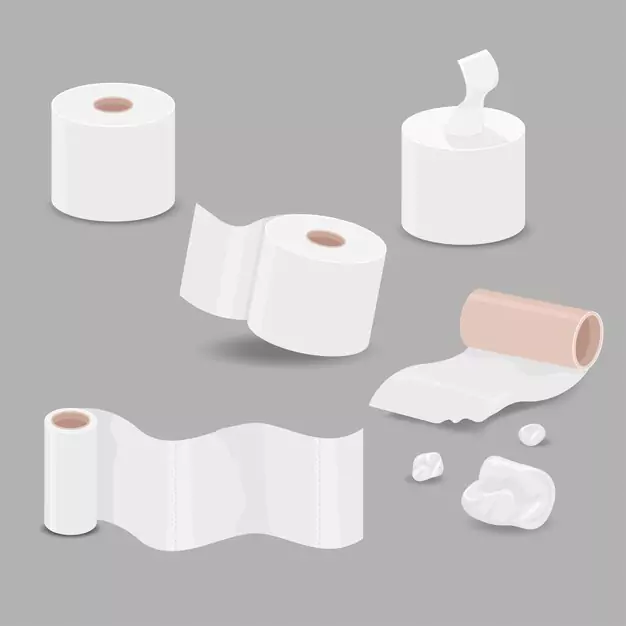
Using paper towels as a substitute for gauze may carry risks and limitations. While paper towel may be absorbent, it lacks the sterile quality and strength of gauze, making them less reliable in wound care and prone to causing further irritation or infection.
It is advisable to use proper medical supplies for optimal safety and effectiveness.
Using paper towels as a substitute for gauze may seem convenient in certain situations, but it is essential to understand the risks and limitations associated with this choice. In this section, we will explore the contamination concerns with paper towels, the potential for irritation or allergic reactions, and the importance of sterile dressing materials.
Contamination Concerns With Paper Towels:
- Paper towels are not designed to be sterile like medical gauze. They are often manufactured for general use and may carry unseen bacteria or other microorganisms.
- Unlike medical gauze, paper towels are not treated to be resistant to contamination, making them potentially unsafe for wound care.
- The fibers in paper towels can easily shed and contaminate the wound site, leading to an increased risk of infection.
Potential Irritation Or Allergic Reactions:
- Paper towels are not designed with the same consideration for sensitive skin as medical gauze. Their rough texture and chemical treatments may irritate the wound or surrounding skin.
- Some individuals may also have allergies or sensitivities to the materials or chemicals used in paper towels, leading to further discomfort or allergic reactions.
Importance Of Sterile Dressing Materials:
- Sterile dressing materials, such as medical gauze, are specifically manufactured to minimize the risk of infection and promote wound healing.
- Medical gauze is sterile and individually packaged to maintain its integrity until use, ensuring a hygienic wound care routine.
- Using non-sterile paper towels increases the risk of introducing harmful bacteria or foreign substances into the wound site, which can hinder the healing process and potentially lead to complications.
While paper towels may appear to be a convenient alternative to gauze in certain situations, it is crucial to recognize and consider the risks involved. Contamination concerns, potential irritation or allergic reactions, and the importance of sterile dressing materials highlight the limitations of using paper towels as a substitute for gauze.
It is always best to prioritize the use of appropriate medical supplies, such as sterile gauze, to promote optimal wound healing and reduce the risk of complications.
When Can Paper Towel Be Used As A Temporary Option?
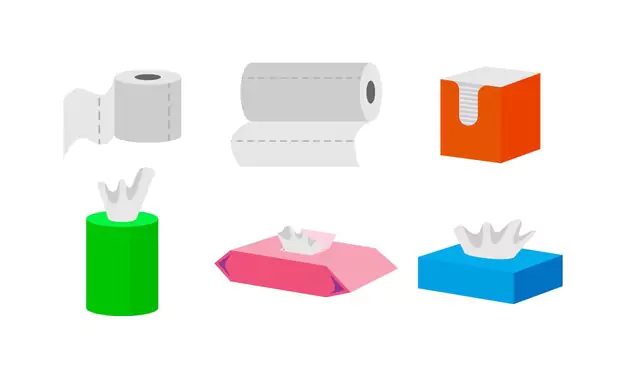
Paper towels can be used as a temporary option instead of gauze in certain situations. It provides a quick and convenient solution for absorbing blood or fluid, although it may not have the same level of absorbency or sterile properties as gauze.
Emergencies or situations where gauze is unavailable:
- First aid situations in which you don’t have access to gauze can prompt the use of paper towels as a temporary option.
- In emergencies or outdoor activities, carrying paper towels is more convenient than gauze.
- If gauze is not readily available during a minor wound, a paper towel can be a quick substitute.
Proper techniques for using paper towels as a temporary dressing:
- Cleanse the wound and surrounding area gently with an antiseptic solution.
- If bleeding hasn’t stopped, place a clean folded paper towel over the wound and apply firm pressure using your hand or a bandage.
- Secure the paper towel in place with adhesive tape or a bandage.
- Monitor the wound for signs of infection, such as redness, swelling, or pus.
- Change the paper towel dressing regularly, ensuring the wound remains clean and dry.
- Avoid leaving paper towels in direct contact with the wound for extended periods to prevent fibers from adhering to the wound.
Seeking medical advice after using a paper towel on a wound:
- Despite using paper towels as a temporary option, it’s essential to seek medical advice from a healthcare professional for proper wound assessment and treatment.
- A healthcare professional can ensure that the wound is not infected and provide appropriate wound care advice.
- Delaying medical attention can lead to complications or prolonged healing time.
Remember, while paper towels can serve as a temporary substitute for gauze in certain situations, it is not a long-term solution. Always seek professional medical assistance to ensure optimal wound care and healing.
Alternatives To Gauze For Proper Wound Care
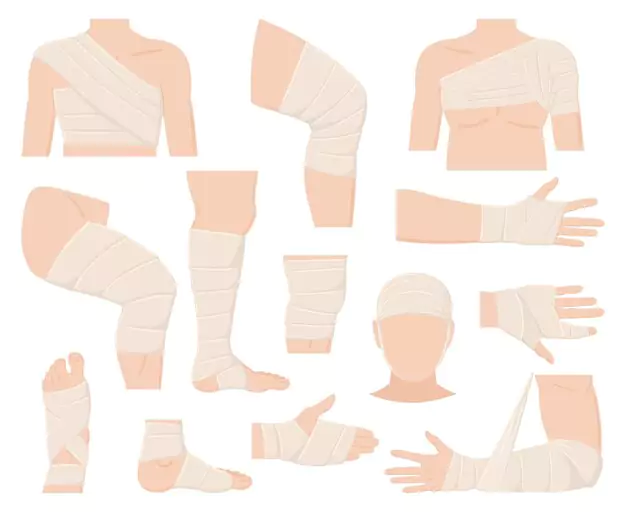
Discover effective alternatives to gauze for proper wound care. Explore the possibility of using paper towels as a convenient option for wound dressing. Find out more about its benefits and suitability for different types of wounds.
When it comes to taking care of wounds, gauze is often the go-to choice for many people. However, there are times when gauze may not be readily available or suitable for certain types of wounds. In such cases, it’s important to know the alternatives to gauze that can still provide effective wound care.
Here are some alternatives to consider:
Sterile Adhesive Bandages And Dressings:
- Adhesive bandages: These are the most common alternative to gauze. They are pre-packaged, sterile, and have an adhesive backing that helps secure the bandage to the skin. Adhesive bandages come in various shapes and sizes, making them suitable for different wound sizes.
- Transparent film dressings: These are thin, transparent sheets with adhesive borders. They create a barrier over the wound, protecting it from dirt and bacteria while allowing observation of the healing process. Transparent dressings are particularly useful for smaller wounds or superficial abrasions.
Non-Stick Pads And Silicone-Based Alternatives:
- Non-stick pads: These are designed to cover and protect wounds without adhering to the wound bed. They are made of a non-adherent material like silicone or Teflon, which minimizes trauma when removing the dressing. Non-stick pads are ideal for wounds that require frequent dressing changes or for sensitive skin.
- Silicone-based dressings: Silicone dressings are designed to provide a moist wound environment while preventing the dressing from sticking to the wound bed. They are highly flexible, conforming to the shape of the wound, and can be left in place for several days depending on the wound condition. Silicone-based dressings are particularly beneficial for burns, ulcers, and surgical wounds.
Consulting Healthcare Professionals For Specialized Dressings:
In some cases, wounds may require specialized dressings that only healthcare professionals can provide. These dressings are tailored to specific wound types and conditions, ensuring optimal healing and prevention of complications. Some examples of specialized dressings include:
- Hydrocolloid dressings: These dressings contain gel-forming agents that create a moist environment to promote wound healing. They are effective for wounds with light to moderate exudate and can remain in place for a few days.
- Alginate dressings: Alginate dressings are made from seaweed fibers and are highly absorbent. They are excellent for wounds with heavy exudates, such as deep ulcers or surgical wounds, as they can effectively absorb and lock in moisture.
- Foam dressings: Foam dressings have a soft, absorbent layer that absorbs moisture and offers cushioning for wounds. They are beneficial for wounds with moderate to heavy exudate and are particularly useful for pressure ulcers or wounds on bony prominences.
Remember, the choice of dressing depends on the nature and severity of the wound, as well as individual patient characteristics. It is always best to consult a healthcare professional for proper wound care guidance and treatment recommendations.
Frequently Asked Questions Of Can I Use Paper Towel Instead Of Gauze
Can Paper Towels Replace Gauze?
Paper towels can be used as a substitute for gauze due to their absorbency and availability.
What Can You Use Instead Of A Gauze?
Bandages, clean cloth, or specialized dressings can be used instead of gauze for wound care.
Can I Put a Paper Towel On A Wound?
No, you should not put a paper towel on a wound. It is not recommended for wound care.
Can You Use Paper Towels To Stop Bleeding?
Yes, paper towels can be used to stop bleeding due to their absorbent properties.
Conclusion
While paper towels may seem like a convenient alternative to gauze, it is important to consider their limitations. Paper towels lack the absorbency and sterility that gauze provides, making them less effective in preventing infection and promoting proper wound healing.
Additionally, the rough texture of paper towels may cause irritation and discomfort to the skin, especially in sensitive areas. It is always recommended to use gauze, which is specifically designed for medical purposes, to ensure optimal wound care. If gauze is not readily available, it is advisable to seek out appropriate alternatives such as sterile dressings or cotton pads.
By prioritizing the use of proper wound care products, we can ensure better outcomes and reduce the risk of complications. Remember, when it comes to your health, it’s important to make informed decisions and prioritize your well-being above convenience.
